Audio mixers are essential to sound production, providing the ability to balance, mix, and process audio signals for a variety of applications.
They come in a variety of shapes and sizes, serving everyone from bedroom podcasters to professional sound engineers overseeing large-scale concerts.
Whether you’re recording music, broadcasting a radio show, or setting up the sound for a live event, finding the best audio mixer can be the control hub that harmonizes all your audio sources.
Audio mixers come in a variety of sizes and capacities, with the smallest, most basic models aimed at project studios or podcasters with minimal requirements, while larger models are ideal for use in concert halls and venues.
In this guide, we’ll take a look at the best audio mixers for the most common creative needs today, and break down exactly what you need to keep in mind when shopping for one of the best audio mixers for your next project.
Best Audio Mixer 2025
1. SSL BiG SiX
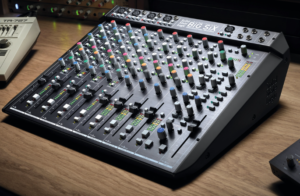
As the name suggests, the BiG SiX is the larger sibling of SSL’s equally impressive SiX.
Like that mixer, the BiG SiX builds on the legacy of SSL’s legendary large-format studio consoles, but in a way that’s aimed primarily at home and project studios.
This model sets the bar high by offering a full 16-channel analogue mixer.
It includes four mono channels with SSL’s SuperAnalogue mic preamps, each with mic/line/Hi-Z inputs, a high-pass filter, SSL channel dynamics, an updated three-band EQ, and a fully balanced insert point.
This is joined by four stereo inputs with dual mono switching.
The analogue appeal is rounded out by three compressor flavors, one of which is an ‘Essential’ version of the classic SSL G-Comp Bus Compressor, featuring the well-known auto-release option.
SSL compressors are a sought-after choice for their ability to ‘glue’ sound sources and add punch to drums, and having access to this functionality in a home studio is a huge draw here.
Most importantly, the BiG SiX improves on SiX’s biggest weakness by adding a 16-channel USB 24-bit/96kHz audio interface.
This is certainly not a cheap option, but the combination of analogue heritage and digital convenience makes it a fantastic device for a small studio setup.
2. SOLID STATE LOGIC BIG SIX
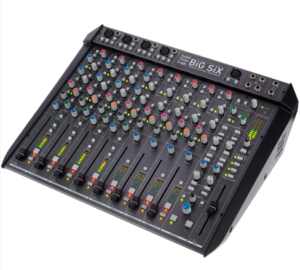
If you’re a professional music producer or audio engineer, Solid State Logic BiG SiX is the ideal choice.
Combining the classic SSL analog sound with extensive DAW integration, it’s perfect for anyone who needs the best of both analog and digital in their creative workflow.
Building on the acclaimed Solid State Logic SiX desktop mixer and incorporating feedback from artists, producers, and engineers to create the next step in SSL hybrid production,
BiG SiX is a studio-grade mixing console that combines the features of legendary large-format SSL consoles with full USB integration,
Additional processing and highly flexible routing are needed to deliver the quality, functionality, and workflow that audio professionals have come to rely on from SSL.
The design delivers the punch, clarity, and ultra-low distortion that engineers love from their 9000 series consoles, along with 16 channels of high-quality AD/DA conversion and the flexibility of a USB interface.
Now with the famous ‘automatic’ release, the essential version of the SSL G-Comp Bus Compressor, channel processing in the form of Dynamics and 3-band EQ based on the iconic SSL 4000E, a comprehensive monitoring section, and up to 18 channels of analog summing during mixdown, the BiG SiX is an essential SSL studio.
3. Rode Rodecaster Pro II
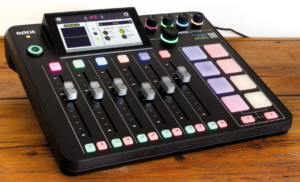
The best player in this category is Rode’s Rodecaster II! The original Rodecaster was an all-in-one studio mixer made for podcasters and was the first of its kind.
As this summary shows, there are many more interfaces like this on the market today, but the Rodecaster has the advantage of being a pioneer in the field.
This podcast mixer has a ton of features aimed at the podcasting market.
Podcasting is an interesting subgenre of home studio mixers, and while it may not make sense for musicians, it has some features that will greatly improve the quality of life for podcasters and content creators.
The Rode RODECaster Pro II offers enough ‘standard’ mixing features for most people, but it’s augmented with some pod-friendly extras like four headphone outputs, hot-swappable action buttons, and the ability to record directly from the device to an SD card or external hard drive.
Four high-quality mic preamps mean your vocals will sound sweet, and the large touchscreen makes it easy to adjust levels and settings.
It’s quite expensive, and the added bells and whistles might not be for everyone, but if your home studio is focused on podcasting, blogging, or streaming, and you’re on a budget, the Rode RODECaster Pro II is worth your time.
The Rodecaster Pro II is not cheap and it’s not for everyone. But for some, it could be perfect.
The Zoom Podtrak has many of the same features, is much better value, and is much more portable. But the Rodecaster Pro II is undoubtedly a bigger and better machine.
4. YAMAHA MGP24X
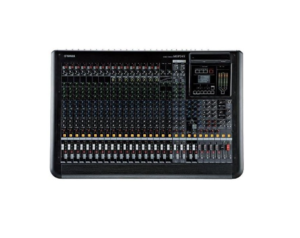
The Yamaha MGP24X is ideal for live performance venues, houses of worship, and touring bands that value the tactile feedback of analog control and the precision of digital enhancement.
It stands out for its hybrid approach that combines the warmth of analog mixing with the capabilities of digital.
The Yamaha MGP24X mixer delivers the warmth and simplicity of analog with sophisticated DSP capabilities in a compact metal chassis packed with refined Yamaha innovations.
The signal path begins with great-sounding D-PRE Class-A mic preamps boasting an inverted Darlington circuit design.
The MGP24X’s X-Pressure EQ delivers the essence of classic vintage EQ, while an intelligent one-knob compressor provides effortless dynamic control.
The Stereo Hybrid channel, featuring Priority Ducker, Leveler, and Stereo Image, offers a new perspective on sound reinforcement in the digital age.
See the evolution of analog mixers: Yamaha’s MGP24X. Yamaha MGP24X at a glance:
A new approach to analog mixing The warmth of analog, the sophistication of digital Stereo hybrid channels combine analog and digital FX, EQ, and more for serious professional production
A new approach to analog mixing With the MGP24X, Yamaha takes a new approach to leveraging digital.
5. BEHRINGER X32 RACK
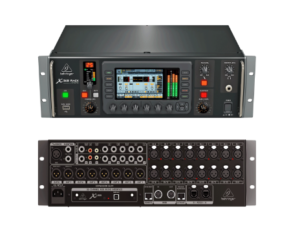
The Behringer X32 Rack combines a powerful digital mixer, multitrack recorder, and audio interface in an all-in-one rack-mountable design, making it ideal for sound engineers, studio professionals, and musicians who need a flexible, portable mixing solution.
The Behringer X32 Rack will change the way you think about digital mixers.
It’s packed with the comprehensive control and sound quality you want from audiophile-grade mic preamps, but since this rack-mounted X32 has no faders, all the controls are accessible via your mobile device.
Every aspect of your mix can be adjusted using the controls on the front of the unit, visible on the high-resolution 5-inch color TFT, and Sweetwater engineers love how Behringer’s free iPad and iPhone app provides full remote operation without a host computer.
You can even run the I/O using inexpensive CAT 5 cables. Embrace the future of live mixing with the Behringer X32 Rack.
6. Roland Go:Mixer Pro X
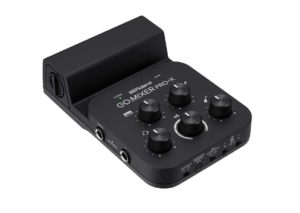
We loved the previous ‘Pro’ version of Roland’s Go:Mixer, but this latest update is a significant improvement across the board.
The Go:Mixer Pro X offers 11 audio input channels (two more than the previous Pro version) and three output channels (one more than the Pro).
This is made up of two (L/mono, R) 1/4-inch jack inputs, two 3.5mm stereo line inputs, a 1/4-inch guitar/bass input, a TRRS smartphone input/output (stereo, CTIA), and a combo XLR/1/4 jack input.
There’s also a headphone or headset jack (stereo, CTIA) and the essential micro USB socket to round out the I/O.
There’s also a much-needed guitar/bass pad to help tame high levels from active pickups and such. Additional switching on the unit includes phantom power, on/off, and loopback functionality.
If you’re primarily looking for a mixer/interface that works with your smartphone or tablet (and a few other devices), the Pro X may be the best option.
7. Behringer XAIR X18
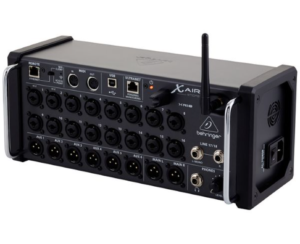
Traditional audio mixers can be bulky and unwieldy, and the Behringer XAIR X18 aims to solve this problem by taking the flexibility and functionality of an audio mixer and moving the entire control set to a touchscreen interface.
This allows the unit to take up less room than its predecessors.
Users can adjust the mixer’s sound from anywhere in the room, which significantly improves the quality of their mixes, transforms the sound into a more complete sound, and brings the benefits of a large console to smaller spaces.
The XAIR X18 features a built-in Wi-Fi chip for tablet connectivity, USB compatibility for audio interface functionality, and a range of built-in effects, including a 31-band equalizer, tube-style compression, and a variety of reverb emulations, all of which can be adjusted via the companion tablet app.
Because it can function as an audio interface, the XAIR X18 could be a great option for recording studios looking to minimize their footprint and get high performance with less gear.
Keep in mind that, unlike other audio interfaces, the X18 relies on a tablet app, which limits the ability to control it directly from a computer.
The mixer also requires users to provide their own tablet to use all of its features, which can add to the mixer’s initial cost.
The companion tablet app itself is relatively intuitive to use but with so many features available,
users will need to spend some time learning the ins and outs of the software to avoid having to troubleshoot issues during live performances or recording sessions.
8. Zoom LiveTrak L-12
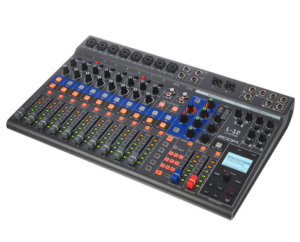
We’re moving away from the traditional ‘home’ studio and into a rehearsal space.
We included the garage because it’s important, right? Even so, bands are likely to need something bigger to record a full gig, demo, or jam session.
We’ve all done the classic ‘one mic in the middle of the room’ recording at some point and dreamed of having more control. The Zoom LiveTrak L-12 has the solution.
This 12-input digital mixer combines the best of both worlds. As a pure mixer, it can record up to 12 sources simultaneously with complete control over levels, panning, effects, and routing.
Then output them as a single summary source, or as individual tracks to your computer via USB for editing and post-production.
Alternatively, the LiveTrak L-12 can also act as a standalone multitrack recorder, allowing you to record, mix, and master full tracks that can be exported to an SD card.
For bands on a tight budget, the Zoom LiveTrak L-12 is a very attractive proposition.
9. PreSonus StudioLive AR8c
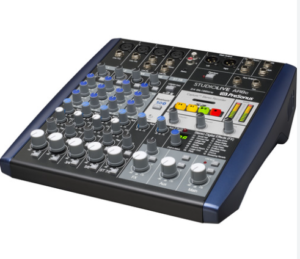
The PreSonus StudioLive AR8c essentially bridges the gap between an audio interface and a mixer, and it does it well.
It comes in a few different sizes, with the larger sizes offering more connectivity, but for us, this eight-channel version is the best.
With it, you get eight analog inputs, including high-quality mic preamps, line-in inputs, and RCA connections, and there are also a few neat tricks to the fact that there’s a channel that allows for Bluetooth audio connectivity. Perfect for podcasting.
When connected to a laptop, it becomes a full-fledged audio interface, allowing you to simultaneously record all inputs to your DAW of choice.
A few effects are added to the overall package, making it a comprehensive and valuable option for small to medium-sized home studios.
FAQ
What does an audio mixer do?
An audio mixer is essentially the routing center of any audio system. It combines multiple audio signals from various sources and sends them to other locations, such as a recording system or amplifier.
These original sources can include microphones, guitars, keyboards, and other audio sources.
Many mixers offer features beyond basic mixing, including creating subgroups, sending audio to multiple locations, equalization for tone shaping, volume control, effects, and more.
What is the difference between analog and digital audio mixers?
An analog mixer uses traditional knobs and fader controls to change the path of the sound signal.
A digital mixer, on the other hand, processes the sound internally using digital signal processing, allowing for greater precision and the ability to store presets.
Are audio mixers worth it?
Any system that combines multiple audio sources needs some kind of audio mixer, so they are not only valuable, they are essential.
No performance venue can function without some form of audio mixer at the center of its amplification system, and recording studios are limited to a single microphone.
Basic audio production, such as streaming and podcasting studios, often requires only one or two microphones and can be managed with a small audio mixer that requires little initial investment.
However, larger, more expensive audio mixers are an inevitable expense for larger venues and studios.
Conclusion
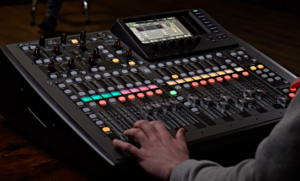
The best audio mixers on the market feature easy-to-access controls and practical connectivity features that make audio routing easier in both the smallest and largest studios.
For performance venues or recording studios that want to save space and take advantage of cutting-edge technology, a digital audio mixer is one of the best options money can buy.
Also read: 10+ Best Portable PA Systems for 2025
